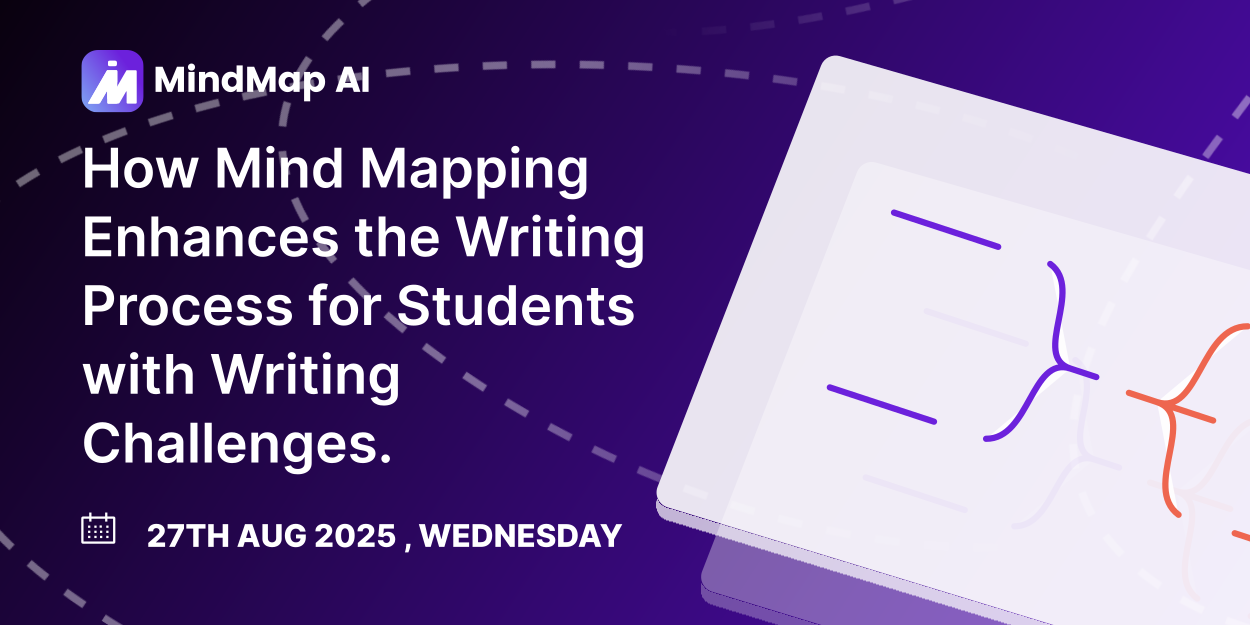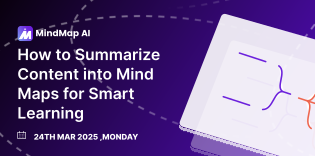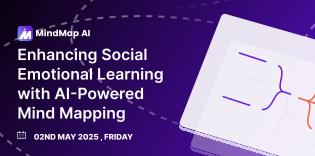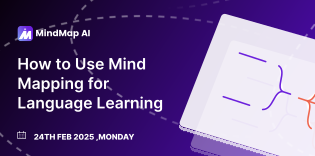
In this webinar hosted by MindMap AI, Brian Friedlander, an Assistive Technology Consultant with over 40 years of experience, showed how mind mapping can unlock the writing process for students who struggle with dyslexia, dysgraphia, ADHD, or language-based learning challenges. With live demonstrations, he explained how AI-powered mind maps reduce “white-screen paralysis,” guide idea generation, and provide visual structure that makes drafting more manageable.
Brian walked attendees through a practical workflow where students start generating ideas using MindMap AI, refine and expand ideas with the AI co-pilot, and then export their mind maps as clean outlines. He also highlighted how to combine mind mapping with assistive technologies such as word prediction for spelling support, text-to-speech for comprehension, and speech-to-text for faster input, giving students multiple pathways to success.
Why Use Mind Mapping for Writing Challenges?
-
Converts blank-page anxiety into concrete, visual prompts that unlock ideation.
-
Breaks big assignments into chunked, manageable branches students can sequence.
-
Keeps focus tight (collapse/expand nodes) to reduce cognitive load and distractions.
-
Bridges planning and drafting by exporting an outline that mirrors the student’s map.
Common Challenges in Student Writing
-
White Screen Paralysis: Difficulty starting a piece of writing from scratch.
-
Weak Ideation: Trouble generating ideas or examples to write about.
-
Poor Organization: Thoughts remain scattered and unstructured.
-
Focus Issues: Students with ADHD lose track of key points or over-focus on details.
-
Skill Gaps: Spelling, grammar, or sentence structure hurdles block expression of ideas.
How MindMap AI Supports Students with Writing Challenges
-
Brainstorming With AI Co-Pilot: Generates ideas and content suggestions to get students started.
-
Interactive Prompts: Students can ask follow-up questions, expand branches, or refine ideas.
-
Integration With Study Materials: Import PDFs, documents, or class notes to build study maps and essay plans.
-
Export Maps: Seamlessly turn a mind map into a structured essay outline.
-
Collaboration and Sharing: Share maps with teachers or tutors for feedback and support.
-
Visual Customization: Use images, symbols, and color coding to help memory and engagement.
What Goes into a Strong Writing Map?
-
Topic & Purpose: Clear central theme plus task cues (inform, explain, argue, narrate).
-
Key Points & Evidence: Branches for claims, examples, quotes, and citations to reduce hunting later.
-
Audience & Language: Notes on word choice, vocabulary level, and background knowledge of readers.
-
Sequence & Transitions: Ordered branches with connectors that preview paragraph flow.
-
AT Checkpoints: Icons for “read back,” “dictate,” or “predict” to remind students when to use tools.
Key Takeaways from Brian’s Webinar
1. Start With Idea Generation
For many students, the hardest part of writing is beginning. App MindMap AI removes that barrier by generating prompts, suggestions, and categories, giving students an immediate starting point.
2. Visualize to Organize
Mind maps help students see relationships between ideas. Moving and regrouping branches keeps thoughts clear and prevents essays from becoming disorganized.
3. Support Diverse Learning Styles
Students with ADHD or dyslexia benefit from visual and auditory support. Mind maps combined with text-to-speech, word prediction, and dictation make writing more inclusive.
4. Connect Brainstorming to Composition
By exporting mind maps to markdowns, students can move directly from brainstorming into structured essays, reducing the gap between thinking and writing.
5. Build Confidence and Independence
When students realize they can generate, organize, and express ideas visually, they gain confidence. This confidence helps them become more independent writers over time.
Frequently Asked Questions (FAQ)
1. How Does Mind Mapping Improve Writing for Students With Learning Challenges?
Provides a visual representation of ideas that reduces cognitive load. Instead of forcing students to start with full sentences, it lets them build thoughts step by step until they’re ready to write in paragraph form.
2. How MindMap AI Helps With Attention Deficit Issues
Students can collapse branches to reduce distractions and focus only on one section at a time. This feature is especially useful for learners with ADHD who need support managing focus.
3. Does Mind Mapping Really Improve Long-Term Writing Skills?
Research shows that using non-linguistic representations like mind maps helps students internalize organization skills. Over time, they become better at structuring essays without needing as much external support.
4. Can Students Use Assistive Tools Alongside MindMap AI?
Absolutely. Tools such as text-to-speech, dictation, and word prediction integrate naturally with mind mapping. Together, they create a powerful workflow for students who struggle with spelling, grammar, or reading.











